Burmese royal patronage Stock Photos and Images
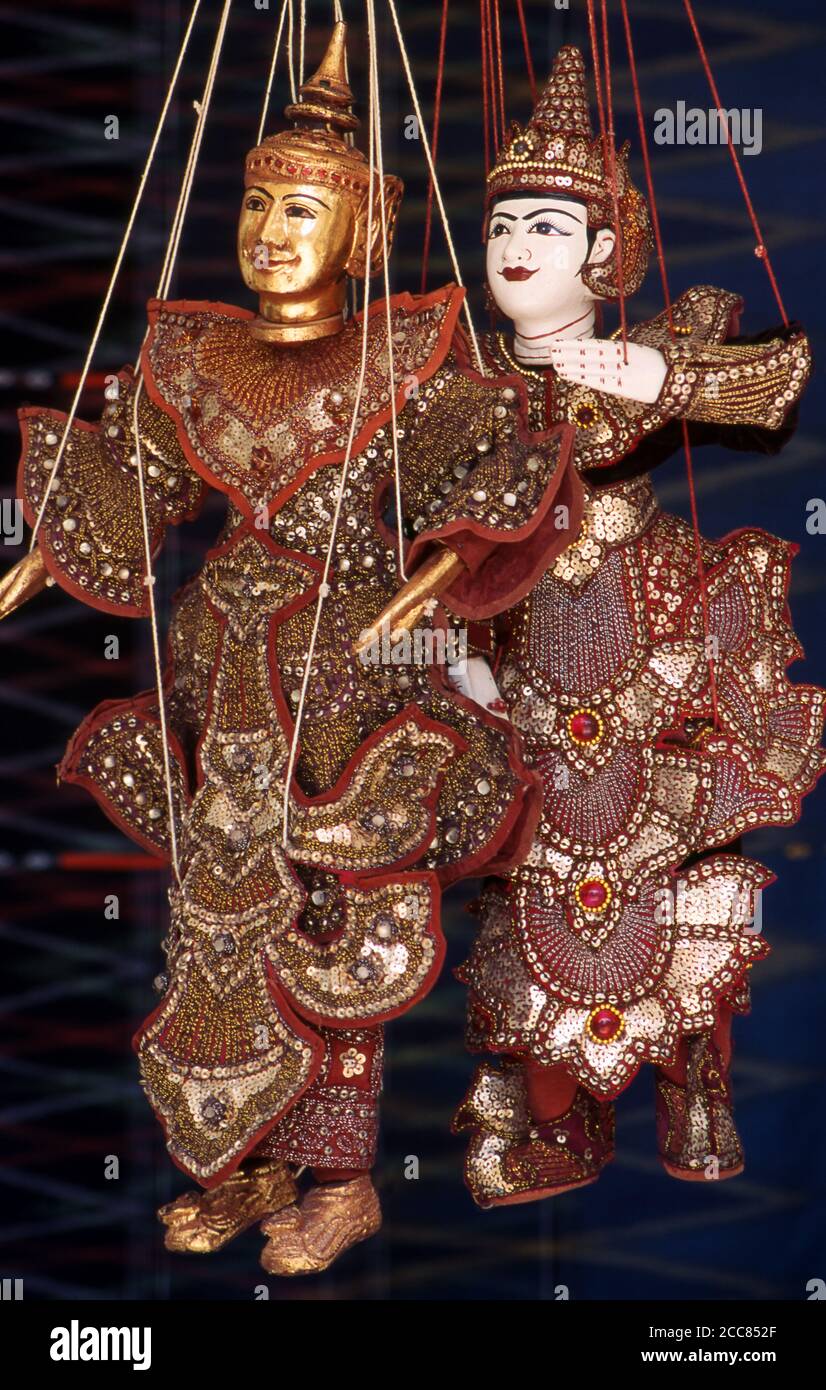 Burma / Myanmar: Traditional Burmese puppets (Yoke thé) on sale, Bogyoke Aung San Market, Yangon (Rangoon). Yoke thé (lit. miniatures) is the Burmese name for marionette puppetry. Although the term can be used for marionettery in general, its usage usually refers to the local form of string puppetry. Like most of Burmese refined art, Yoke thé performances originated from Royal patronage and were gradually adapted for the wider populace. Yoke thé are almost always performed in operas. Stock Photohttps://www.alamy.com/image-license-details/?v=1https://www.alamy.com/burma-myanmar-traditional-burmese-puppets-yoke-th-on-sale-bogyoke-aung-san-market-yangon-rangoon-yoke-th-lit-miniatures-is-the-burmese-name-for-marionette-puppetry-although-the-term-can-be-used-for-marionettery-in-general-its-usage-usually-refers-to-the-local-form-of-string-puppetry-like-most-of-burmese-refined-art-yoke-th-performances-originated-from-royal-patronage-and-were-gradually-adapted-for-the-wider-populace-yoke-th-are-almost-always-performed-in-operas-image368973207.html
Burma / Myanmar: Traditional Burmese puppets (Yoke thé) on sale, Bogyoke Aung San Market, Yangon (Rangoon). Yoke thé (lit. miniatures) is the Burmese name for marionette puppetry. Although the term can be used for marionettery in general, its usage usually refers to the local form of string puppetry. Like most of Burmese refined art, Yoke thé performances originated from Royal patronage and were gradually adapted for the wider populace. Yoke thé are almost always performed in operas. Stock Photohttps://www.alamy.com/image-license-details/?v=1https://www.alamy.com/burma-myanmar-traditional-burmese-puppets-yoke-th-on-sale-bogyoke-aung-san-market-yangon-rangoon-yoke-th-lit-miniatures-is-the-burmese-name-for-marionette-puppetry-although-the-term-can-be-used-for-marionettery-in-general-its-usage-usually-refers-to-the-local-form-of-string-puppetry-like-most-of-burmese-refined-art-yoke-th-performances-originated-from-royal-patronage-and-were-gradually-adapted-for-the-wider-populace-yoke-th-are-almost-always-performed-in-operas-image368973207.htmlRM2CC852F–Burma / Myanmar: Traditional Burmese puppets (Yoke thé) on sale, Bogyoke Aung San Market, Yangon (Rangoon). Yoke thé (lit. miniatures) is the Burmese name for marionette puppetry. Although the term can be used for marionettery in general, its usage usually refers to the local form of string puppetry. Like most of Burmese refined art, Yoke thé performances originated from Royal patronage and were gradually adapted for the wider populace. Yoke thé are almost always performed in operas.
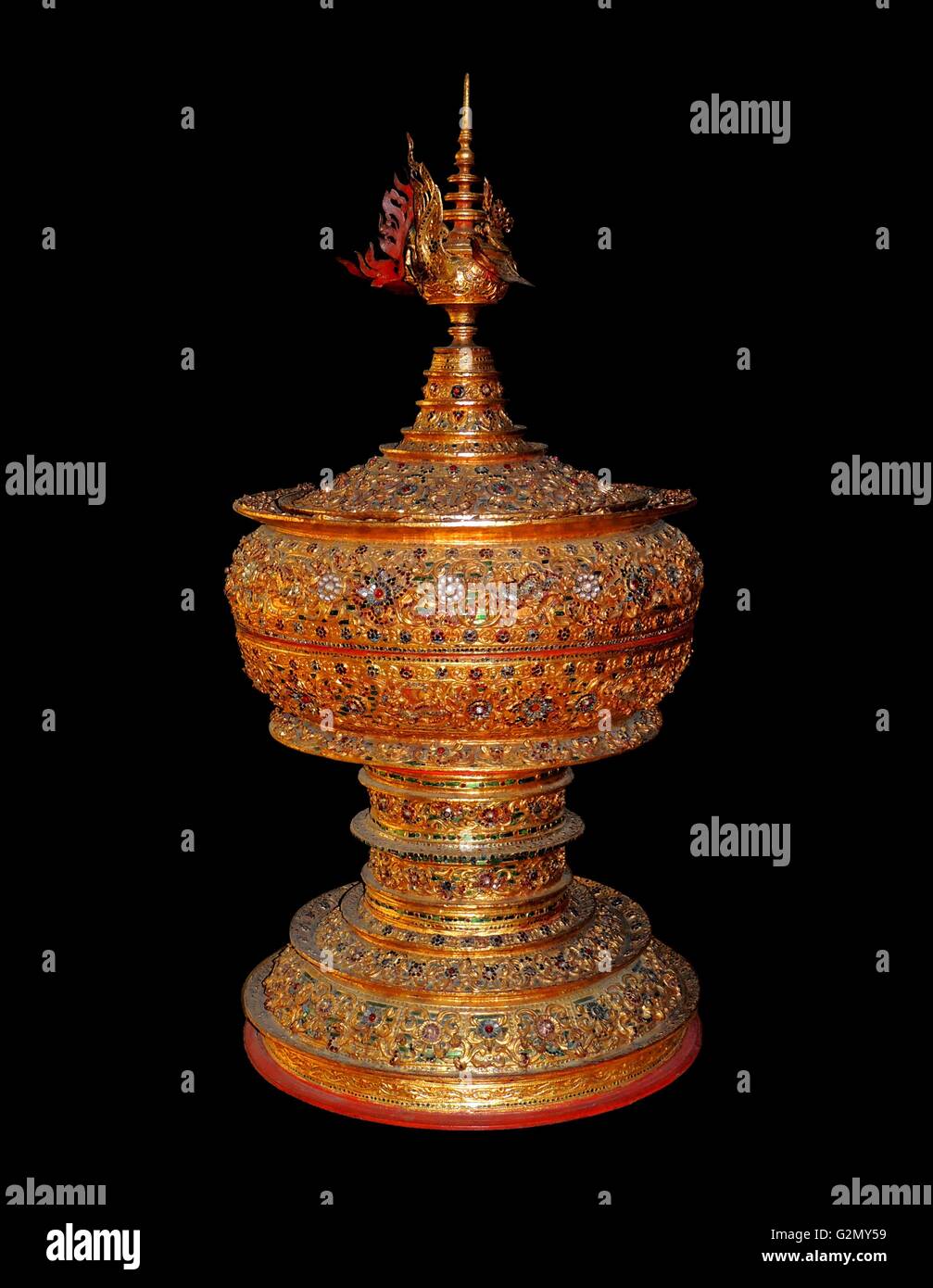 Lidded offering vessels, Burma, probably from Mandalay (the Burmese capital). 19th century. Such excellent examples almost certainly reflect royal patronage. Stock Photohttps://www.alamy.com/image-license-details/?v=1https://www.alamy.com/stock-photo-lidded-offering-vessels-burma-probably-from-mandalay-the-burmese-capital-104951877.html
Lidded offering vessels, Burma, probably from Mandalay (the Burmese capital). 19th century. Such excellent examples almost certainly reflect royal patronage. Stock Photohttps://www.alamy.com/image-license-details/?v=1https://www.alamy.com/stock-photo-lidded-offering-vessels-burma-probably-from-mandalay-the-burmese-capital-104951877.htmlRMG2MY59–Lidded offering vessels, Burma, probably from Mandalay (the Burmese capital). 19th century. Such excellent examples almost certainly reflect royal patronage.
 Lemyethna Temple Bagan Myanmar // BAGAN, Myanmar — Lemyethna Temple (also known as Lemyethna Pagoda) displays its white painted exterior in the Minnanthu area of the Bagan Archaeological Zone. Constructed in 1223 CE during the reign of King Htilominlo, this Buddhist temple was built by Anandathura, a minister at the royal court, as documented in contemporary stone inscriptions preserved at the site. The temple follows the classic late Pagan architectural style with a square central shrine and porches projecting from all four cardinal directions, earning it the designation 'Temple of the Four F Stock Photohttps://www.alamy.com/image-license-details/?v=1https://www.alamy.com/lemyethna-temple-bagan-myanmar-bagan-myanmar-lemyethna-temple-also-known-as-lemyethna-pagoda-displays-its-white-painted-exterior-in-the-minnanthu-area-of-the-bagan-archaeological-zone-constructed-in-1223-ce-during-the-reign-of-king-htilominlo-this-buddhist-temple-was-built-by-anandathura-a-minister-at-the-royal-court-as-documented-in-contemporary-stone-inscriptions-preserved-at-the-site-the-temple-follows-the-classic-late-pagan-architectural-style-with-a-square-central-shrine-and-porches-projecting-from-all-four-cardinal-directions-earning-it-the-designation-temple-of-the-four-f-image211495642.html
Lemyethna Temple Bagan Myanmar // BAGAN, Myanmar — Lemyethna Temple (also known as Lemyethna Pagoda) displays its white painted exterior in the Minnanthu area of the Bagan Archaeological Zone. Constructed in 1223 CE during the reign of King Htilominlo, this Buddhist temple was built by Anandathura, a minister at the royal court, as documented in contemporary stone inscriptions preserved at the site. The temple follows the classic late Pagan architectural style with a square central shrine and porches projecting from all four cardinal directions, earning it the designation 'Temple of the Four F Stock Photohttps://www.alamy.com/image-license-details/?v=1https://www.alamy.com/lemyethna-temple-bagan-myanmar-bagan-myanmar-lemyethna-temple-also-known-as-lemyethna-pagoda-displays-its-white-painted-exterior-in-the-minnanthu-area-of-the-bagan-archaeological-zone-constructed-in-1223-ce-during-the-reign-of-king-htilominlo-this-buddhist-temple-was-built-by-anandathura-a-minister-at-the-royal-court-as-documented-in-contemporary-stone-inscriptions-preserved-at-the-site-the-temple-follows-the-classic-late-pagan-architectural-style-with-a-square-central-shrine-and-porches-projecting-from-all-four-cardinal-directions-earning-it-the-designation-temple-of-the-four-f-image211495642.htmlRMP82CRP–Lemyethna Temple Bagan Myanmar // BAGAN, Myanmar — Lemyethna Temple (also known as Lemyethna Pagoda) displays its white painted exterior in the Minnanthu area of the Bagan Archaeological Zone. Constructed in 1223 CE during the reign of King Htilominlo, this Buddhist temple was built by Anandathura, a minister at the royal court, as documented in contemporary stone inscriptions preserved at the site. The temple follows the classic late Pagan architectural style with a square central shrine and porches projecting from all four cardinal directions, earning it the designation 'Temple of the Four F
 Exterior of the Golden Monastery of the Burmese Queen Supayalat in Mandalay; The Queens Golden Kyoung. Part of travel album with pictures of sights in Burma. Stock Photohttps://www.alamy.com/image-license-details/?v=1https://www.alamy.com/exterior-of-the-golden-monastery-of-the-burmese-queen-supayalat-in-mandalay-the-queens-golden-kyoung-part-of-travel-album-with-pictures-of-sights-in-burma-image432737701.html
Exterior of the Golden Monastery of the Burmese Queen Supayalat in Mandalay; The Queens Golden Kyoung. Part of travel album with pictures of sights in Burma. Stock Photohttps://www.alamy.com/image-license-details/?v=1https://www.alamy.com/exterior-of-the-golden-monastery-of-the-burmese-queen-supayalat-in-mandalay-the-queens-golden-kyoung-part-of-travel-album-with-pictures-of-sights-in-burma-image432737701.htmlRM2G40W9W–Exterior of the Golden Monastery of the Burmese Queen Supayalat in Mandalay; The Queens Golden Kyoung. Part of travel album with pictures of sights in Burma.
 Burma / Myanmar: A traditional Burmese elephant puppet (Yoke thé) on sale, Bogyoke Aung San Market, Yangon (Rangoon). Yoke thé (lit. miniatures) is the Burmese name for marionette puppetry. Although the term can be used for marionettery in general, its usage usually refers to the local form of string puppetry. Like most of Burmese refined art, Yoke thé performances originated from Royal patronage and were gradually adapted for the wider populace. Yoke thé are almost always performed in operas. Stock Photohttps://www.alamy.com/image-license-details/?v=1https://www.alamy.com/burma-myanmar-a-traditional-burmese-elephant-puppet-yoke-th-on-sale-bogyoke-aung-san-market-yangon-rangoon-yoke-th-lit-miniatures-is-the-burmese-name-for-marionette-puppetry-although-the-term-can-be-used-for-marionettery-in-general-its-usage-usually-refers-to-the-local-form-of-string-puppetry-like-most-of-burmese-refined-art-yoke-th-performances-originated-from-royal-patronage-and-were-gradually-adapted-for-the-wider-populace-yoke-th-are-almost-always-performed-in-operas-image368973247.html
Burma / Myanmar: A traditional Burmese elephant puppet (Yoke thé) on sale, Bogyoke Aung San Market, Yangon (Rangoon). Yoke thé (lit. miniatures) is the Burmese name for marionette puppetry. Although the term can be used for marionettery in general, its usage usually refers to the local form of string puppetry. Like most of Burmese refined art, Yoke thé performances originated from Royal patronage and were gradually adapted for the wider populace. Yoke thé are almost always performed in operas. Stock Photohttps://www.alamy.com/image-license-details/?v=1https://www.alamy.com/burma-myanmar-a-traditional-burmese-elephant-puppet-yoke-th-on-sale-bogyoke-aung-san-market-yangon-rangoon-yoke-th-lit-miniatures-is-the-burmese-name-for-marionette-puppetry-although-the-term-can-be-used-for-marionettery-in-general-its-usage-usually-refers-to-the-local-form-of-string-puppetry-like-most-of-burmese-refined-art-yoke-th-performances-originated-from-royal-patronage-and-were-gradually-adapted-for-the-wider-populace-yoke-th-are-almost-always-performed-in-operas-image368973247.htmlRM2CC853Y–Burma / Myanmar: A traditional Burmese elephant puppet (Yoke thé) on sale, Bogyoke Aung San Market, Yangon (Rangoon). Yoke thé (lit. miniatures) is the Burmese name for marionette puppetry. Although the term can be used for marionettery in general, its usage usually refers to the local form of string puppetry. Like most of Burmese refined art, Yoke thé performances originated from Royal patronage and were gradually adapted for the wider populace. Yoke thé are almost always performed in operas.
 Lidded offering vessels, Burma, probably from Mandalay (the Burmese capital). 19th century. Such excellent examples almost certainly reflect royal patronage. Stock Photohttps://www.alamy.com/image-license-details/?v=1https://www.alamy.com/stock-photo-lidded-offering-vessels-burma-probably-from-mandalay-the-burmese-capital-104951145.html
Lidded offering vessels, Burma, probably from Mandalay (the Burmese capital). 19th century. Such excellent examples almost certainly reflect royal patronage. Stock Photohttps://www.alamy.com/image-license-details/?v=1https://www.alamy.com/stock-photo-lidded-offering-vessels-burma-probably-from-mandalay-the-burmese-capital-104951145.htmlRMG2MX75–Lidded offering vessels, Burma, probably from Mandalay (the Burmese capital). 19th century. Such excellent examples almost certainly reflect royal patronage.
 Lemyethna Temple Bagan Myanmar // BAGAN, Myanmar — Lemyethna Temple (also known as Lemyethna Pagoda) is a 13th-century Buddhist temple constructed in 1223 CE during the reign of King Htilominlo. Built by Anandathura, a minister at the royal court, this square-based temple features four shrine rooms facing the cardinal directions, earning it the designation 'Temple of the Four Faces.' The temple serves as the centerpiece of an extensive monastic complex comprising over 50 associated structures in the Minnanthu area of Bagan. Lemyethna represents one of the final major temple projects of the Pag Stock Photohttps://www.alamy.com/image-license-details/?v=1https://www.alamy.com/stock-photo-lemyethna-temple-bagan-myanmar-bagan-myanmar-lemyethna-temple-also-132917891.html
Lemyethna Temple Bagan Myanmar // BAGAN, Myanmar — Lemyethna Temple (also known as Lemyethna Pagoda) is a 13th-century Buddhist temple constructed in 1223 CE during the reign of King Htilominlo. Built by Anandathura, a minister at the royal court, this square-based temple features four shrine rooms facing the cardinal directions, earning it the designation 'Temple of the Four Faces.' The temple serves as the centerpiece of an extensive monastic complex comprising over 50 associated structures in the Minnanthu area of Bagan. Lemyethna represents one of the final major temple projects of the Pag Stock Photohttps://www.alamy.com/image-license-details/?v=1https://www.alamy.com/stock-photo-lemyethna-temple-bagan-myanmar-bagan-myanmar-lemyethna-temple-also-132917891.htmlRMHM6X3F–Lemyethna Temple Bagan Myanmar // BAGAN, Myanmar — Lemyethna Temple (also known as Lemyethna Pagoda) is a 13th-century Buddhist temple constructed in 1223 CE during the reign of King Htilominlo. Built by Anandathura, a minister at the royal court, this square-based temple features four shrine rooms facing the cardinal directions, earning it the designation 'Temple of the Four Faces.' The temple serves as the centerpiece of an extensive monastic complex comprising over 50 associated structures in the Minnanthu area of Bagan. Lemyethna represents one of the final major temple projects of the Pag
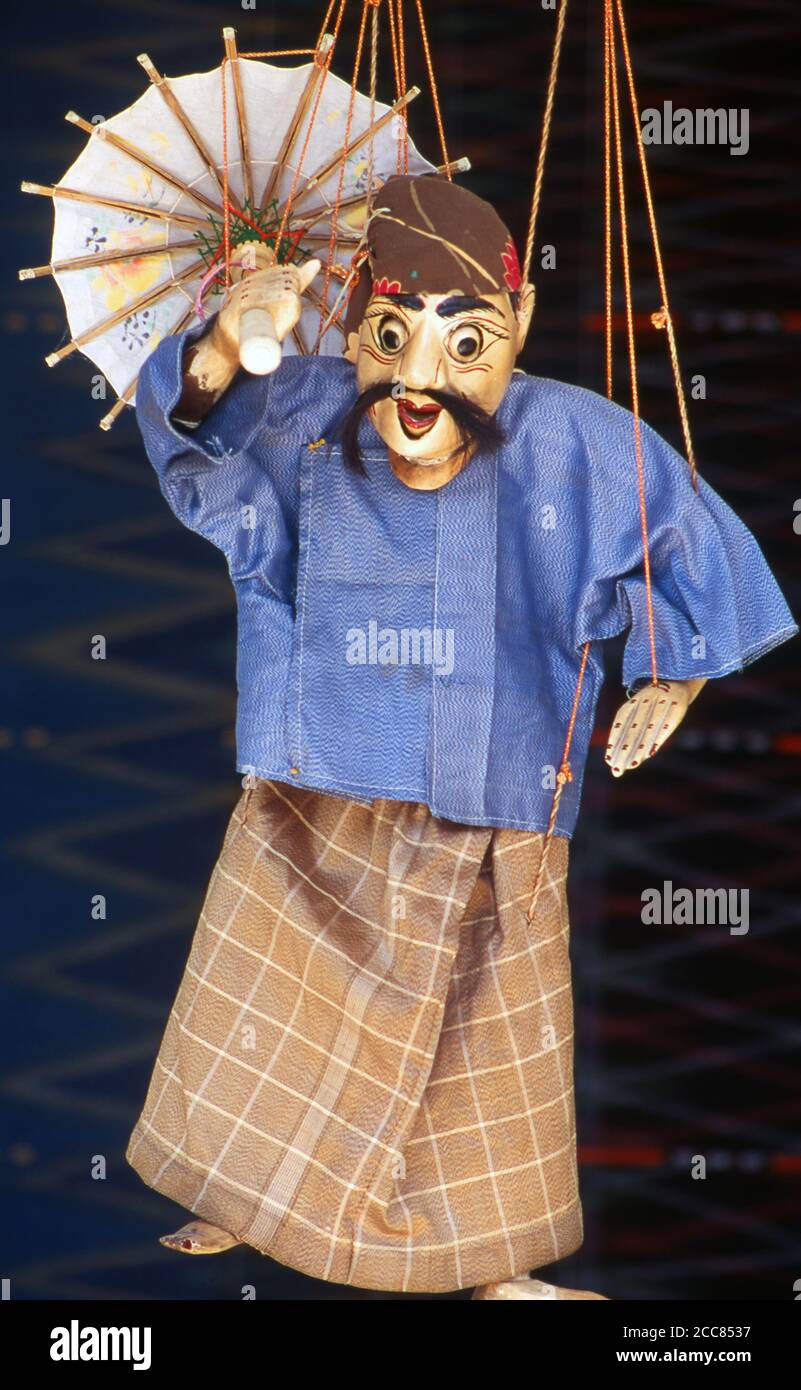 Burma / Myanmar: A traditional Burmese puppet (Yoke thé) on sale, Bogyoke Aung San Market, Yangon (Rangoon). Yoke thé (lit. miniatures) is the Burmese name for marionette puppetry. Although the term can be used for marionettery in general, its usage usually refers to the local form of string puppetry. Like most of Burmese refined art, Yoke thé performances originated from Royal patronage and were gradually adapted for the wider populace. Yoke thé are almost always performed in operas. Stock Photohttps://www.alamy.com/image-license-details/?v=1https://www.alamy.com/burma-myanmar-a-traditional-burmese-puppet-yoke-th-on-sale-bogyoke-aung-san-market-yangon-rangoon-yoke-th-lit-miniatures-is-the-burmese-name-for-marionette-puppetry-although-the-term-can-be-used-for-marionettery-in-general-its-usage-usually-refers-to-the-local-form-of-string-puppetry-like-most-of-burmese-refined-art-yoke-th-performances-originated-from-royal-patronage-and-were-gradually-adapted-for-the-wider-populace-yoke-th-are-almost-always-performed-in-operas-image368973227.html
Burma / Myanmar: A traditional Burmese puppet (Yoke thé) on sale, Bogyoke Aung San Market, Yangon (Rangoon). Yoke thé (lit. miniatures) is the Burmese name for marionette puppetry. Although the term can be used for marionettery in general, its usage usually refers to the local form of string puppetry. Like most of Burmese refined art, Yoke thé performances originated from Royal patronage and were gradually adapted for the wider populace. Yoke thé are almost always performed in operas. Stock Photohttps://www.alamy.com/image-license-details/?v=1https://www.alamy.com/burma-myanmar-a-traditional-burmese-puppet-yoke-th-on-sale-bogyoke-aung-san-market-yangon-rangoon-yoke-th-lit-miniatures-is-the-burmese-name-for-marionette-puppetry-although-the-term-can-be-used-for-marionettery-in-general-its-usage-usually-refers-to-the-local-form-of-string-puppetry-like-most-of-burmese-refined-art-yoke-th-performances-originated-from-royal-patronage-and-were-gradually-adapted-for-the-wider-populace-yoke-th-are-almost-always-performed-in-operas-image368973227.htmlRM2CC8537–Burma / Myanmar: A traditional Burmese puppet (Yoke thé) on sale, Bogyoke Aung San Market, Yangon (Rangoon). Yoke thé (lit. miniatures) is the Burmese name for marionette puppetry. Although the term can be used for marionettery in general, its usage usually refers to the local form of string puppetry. Like most of Burmese refined art, Yoke thé performances originated from Royal patronage and were gradually adapted for the wider populace. Yoke thé are almost always performed in operas.
 Lemyethna Temple Golden Buddha Statue Bagan Myanmar // BAGAN, Myanmar — A large golden Buddha statue occupies one of the cardinal shrines at Lemyethna Temple (also known as the Temple of the Four Faces), a Buddhist temple constructed in 1223 CE during the reign of King Htilominlo. Built by Anandathura, a minister at the royal court, the temple features four shrine rooms facing the cardinal directions, each housing a Buddha statue. Lemyethna Temple represents one of the final major temple projects of the Pagan dynasty and serves as the centerpiece of an extensive monastic complex comprising ove Stock Photohttps://www.alamy.com/image-license-details/?v=1https://www.alamy.com/stock-photo-lemyethna-temple-golden-buddha-statue-bagan-myanmar-bagan-myanmar-132917828.html
Lemyethna Temple Golden Buddha Statue Bagan Myanmar // BAGAN, Myanmar — A large golden Buddha statue occupies one of the cardinal shrines at Lemyethna Temple (also known as the Temple of the Four Faces), a Buddhist temple constructed in 1223 CE during the reign of King Htilominlo. Built by Anandathura, a minister at the royal court, the temple features four shrine rooms facing the cardinal directions, each housing a Buddha statue. Lemyethna Temple represents one of the final major temple projects of the Pagan dynasty and serves as the centerpiece of an extensive monastic complex comprising ove Stock Photohttps://www.alamy.com/image-license-details/?v=1https://www.alamy.com/stock-photo-lemyethna-temple-golden-buddha-statue-bagan-myanmar-bagan-myanmar-132917828.htmlRMHM6X18–Lemyethna Temple Golden Buddha Statue Bagan Myanmar // BAGAN, Myanmar — A large golden Buddha statue occupies one of the cardinal shrines at Lemyethna Temple (also known as the Temple of the Four Faces), a Buddhist temple constructed in 1223 CE during the reign of King Htilominlo. Built by Anandathura, a minister at the royal court, the temple features four shrine rooms facing the cardinal directions, each housing a Buddha statue. Lemyethna Temple represents one of the final major temple projects of the Pagan dynasty and serves as the centerpiece of an extensive monastic complex comprising ove
 Burma / Myanmar: A traditional Burmese puppet (Yoke thé) on sale, Bogyoke Aung San Market, Yangon (Rangoon). Yoke thé (lit. miniatures) is the Burmese name for marionette puppetry. Although the term can be used for marionettery in general, its usage usually refers to the local form of string puppetry. Like most of Burmese refined art, Yoke thé performances originated from Royal patronage and were gradually adapted for the wider populace. Yoke thé are almost always performed in operas. Stock Photohttps://www.alamy.com/image-license-details/?v=1https://www.alamy.com/burma-myanmar-a-traditional-burmese-puppet-yoke-th-on-sale-bogyoke-aung-san-market-yangon-rangoon-yoke-th-lit-miniatures-is-the-burmese-name-for-marionette-puppetry-although-the-term-can-be-used-for-marionettery-in-general-its-usage-usually-refers-to-the-local-form-of-string-puppetry-like-most-of-burmese-refined-art-yoke-th-performances-originated-from-royal-patronage-and-were-gradually-adapted-for-the-wider-populace-yoke-th-are-almost-always-performed-in-operas-image368973239.html
Burma / Myanmar: A traditional Burmese puppet (Yoke thé) on sale, Bogyoke Aung San Market, Yangon (Rangoon). Yoke thé (lit. miniatures) is the Burmese name for marionette puppetry. Although the term can be used for marionettery in general, its usage usually refers to the local form of string puppetry. Like most of Burmese refined art, Yoke thé performances originated from Royal patronage and were gradually adapted for the wider populace. Yoke thé are almost always performed in operas. Stock Photohttps://www.alamy.com/image-license-details/?v=1https://www.alamy.com/burma-myanmar-a-traditional-burmese-puppet-yoke-th-on-sale-bogyoke-aung-san-market-yangon-rangoon-yoke-th-lit-miniatures-is-the-burmese-name-for-marionette-puppetry-although-the-term-can-be-used-for-marionettery-in-general-its-usage-usually-refers-to-the-local-form-of-string-puppetry-like-most-of-burmese-refined-art-yoke-th-performances-originated-from-royal-patronage-and-were-gradually-adapted-for-the-wider-populace-yoke-th-are-almost-always-performed-in-operas-image368973239.htmlRM2CC853K–Burma / Myanmar: A traditional Burmese puppet (Yoke thé) on sale, Bogyoke Aung San Market, Yangon (Rangoon). Yoke thé (lit. miniatures) is the Burmese name for marionette puppetry. Although the term can be used for marionettery in general, its usage usually refers to the local form of string puppetry. Like most of Burmese refined art, Yoke thé performances originated from Royal patronage and were gradually adapted for the wider populace. Yoke thé are almost always performed in operas.
 Lemyethna Temple Frescoes Bagan Myanmar // BAGAN, Myanmar — Intricate frescoes composed of small tile-like illustrations creating geometric patterns adorn the interior walls and ceilings of Lemyethna Temple (also known as Lemyethna Pagoda), a Buddhist temple constructed in 1223 CE during the reign of King Htilominlo. Built by Anandathura, a minister at the royal court, the temple features a square base with elaborate stucco decorations and four shrine rooms housing Buddha statues facing the cardinal directions. The temple's decorative program originally included extensive mural paintings depic Stock Photohttps://www.alamy.com/image-license-details/?v=1https://www.alamy.com/stock-photo-lemyethna-temple-frescoes-bagan-myanmar-bagan-myanmar-intricate-frescoes-132917755.html
Lemyethna Temple Frescoes Bagan Myanmar // BAGAN, Myanmar — Intricate frescoes composed of small tile-like illustrations creating geometric patterns adorn the interior walls and ceilings of Lemyethna Temple (also known as Lemyethna Pagoda), a Buddhist temple constructed in 1223 CE during the reign of King Htilominlo. Built by Anandathura, a minister at the royal court, the temple features a square base with elaborate stucco decorations and four shrine rooms housing Buddha statues facing the cardinal directions. The temple's decorative program originally included extensive mural paintings depic Stock Photohttps://www.alamy.com/image-license-details/?v=1https://www.alamy.com/stock-photo-lemyethna-temple-frescoes-bagan-myanmar-bagan-myanmar-intricate-frescoes-132917755.htmlRMHM6WXK–Lemyethna Temple Frescoes Bagan Myanmar // BAGAN, Myanmar — Intricate frescoes composed of small tile-like illustrations creating geometric patterns adorn the interior walls and ceilings of Lemyethna Temple (also known as Lemyethna Pagoda), a Buddhist temple constructed in 1223 CE during the reign of King Htilominlo. Built by Anandathura, a minister at the royal court, the temple features a square base with elaborate stucco decorations and four shrine rooms housing Buddha statues facing the cardinal directions. The temple's decorative program originally included extensive mural paintings depic
 Burma / Myanmar: A traditional Burmese puppet (Yoke thé) on sale, Bogyoke Aung San Market, Yangon (Rangoon). Yoke thé (lit. miniatures) is the Burmese name for marionette puppetry. Although the term can be used for marionettery in general, its usage usually refers to the local form of string puppetry. Like most of Burmese refined art, Yoke thé performances originated from Royal patronage and were gradually adapted for the wider populace. Yoke thé are almost always performed in operas. Stock Photohttps://www.alamy.com/image-license-details/?v=1https://www.alamy.com/burma-myanmar-a-traditional-burmese-puppet-yoke-th-on-sale-bogyoke-aung-san-market-yangon-rangoon-yoke-th-lit-miniatures-is-the-burmese-name-for-marionette-puppetry-although-the-term-can-be-used-for-marionettery-in-general-its-usage-usually-refers-to-the-local-form-of-string-puppetry-like-most-of-burmese-refined-art-yoke-th-performances-originated-from-royal-patronage-and-were-gradually-adapted-for-the-wider-populace-yoke-th-are-almost-always-performed-in-operas-image368973243.html
Burma / Myanmar: A traditional Burmese puppet (Yoke thé) on sale, Bogyoke Aung San Market, Yangon (Rangoon). Yoke thé (lit. miniatures) is the Burmese name for marionette puppetry. Although the term can be used for marionettery in general, its usage usually refers to the local form of string puppetry. Like most of Burmese refined art, Yoke thé performances originated from Royal patronage and were gradually adapted for the wider populace. Yoke thé are almost always performed in operas. Stock Photohttps://www.alamy.com/image-license-details/?v=1https://www.alamy.com/burma-myanmar-a-traditional-burmese-puppet-yoke-th-on-sale-bogyoke-aung-san-market-yangon-rangoon-yoke-th-lit-miniatures-is-the-burmese-name-for-marionette-puppetry-although-the-term-can-be-used-for-marionettery-in-general-its-usage-usually-refers-to-the-local-form-of-string-puppetry-like-most-of-burmese-refined-art-yoke-th-performances-originated-from-royal-patronage-and-were-gradually-adapted-for-the-wider-populace-yoke-th-are-almost-always-performed-in-operas-image368973243.htmlRM2CC853R–Burma / Myanmar: A traditional Burmese puppet (Yoke thé) on sale, Bogyoke Aung San Market, Yangon (Rangoon). Yoke thé (lit. miniatures) is the Burmese name for marionette puppetry. Although the term can be used for marionettery in general, its usage usually refers to the local form of string puppetry. Like most of Burmese refined art, Yoke thé performances originated from Royal patronage and were gradually adapted for the wider populace. Yoke thé are almost always performed in operas.
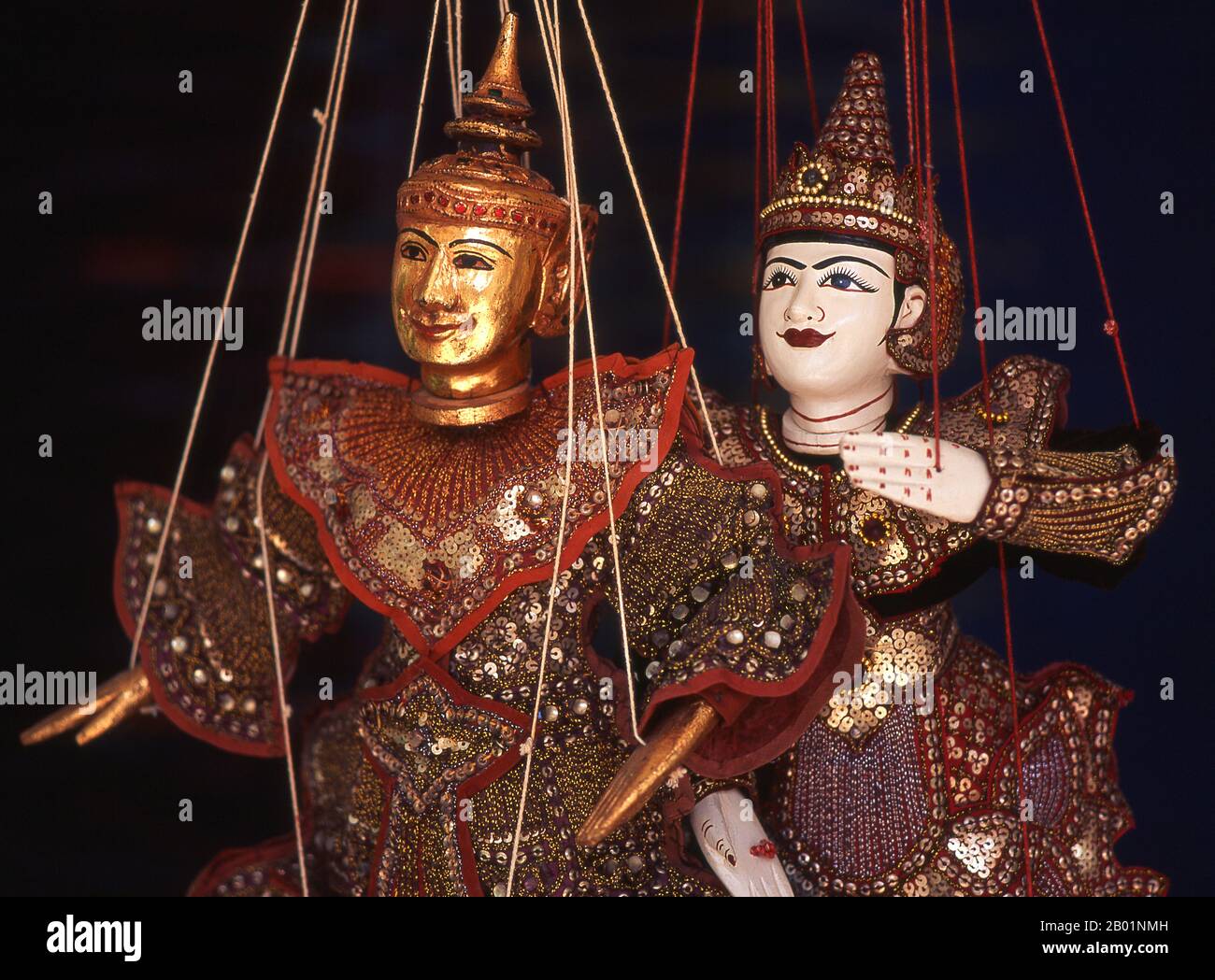 Burma/Myanmar: Traditional Burmese puppets (Yoke thé) on sale, Bogyoke Aung San Market, Yangon (Rangoon). Yoke thé (lit. miniatures) is the Burmese name for marionette puppetry. Although the term can be used for marionettery in general, its usage usually refers to the local form of string puppetry. Like most of Burmese refined art, Yoke thé performances originated from Royal patronage and were gradually adapted for the wider populace. Yoke thé are almost always performed in operas. Stock Photohttps://www.alamy.com/image-license-details/?v=1https://www.alamy.com/burmamyanmar-traditional-burmese-puppets-yoke-th-on-sale-bogyoke-aung-san-market-yangon-rangoon-yoke-th-lit-miniatures-is-the-burmese-name-for-marionette-puppetry-although-the-term-can-be-used-for-marionettery-in-general-its-usage-usually-refers-to-the-local-form-of-string-puppetry-like-most-of-burmese-refined-art-yoke-th-performances-originated-from-royal-patronage-and-were-gradually-adapted-for-the-wider-populace-yoke-th-are-almost-always-performed-in-operas-image344246353.html
Burma/Myanmar: Traditional Burmese puppets (Yoke thé) on sale, Bogyoke Aung San Market, Yangon (Rangoon). Yoke thé (lit. miniatures) is the Burmese name for marionette puppetry. Although the term can be used for marionettery in general, its usage usually refers to the local form of string puppetry. Like most of Burmese refined art, Yoke thé performances originated from Royal patronage and were gradually adapted for the wider populace. Yoke thé are almost always performed in operas. Stock Photohttps://www.alamy.com/image-license-details/?v=1https://www.alamy.com/burmamyanmar-traditional-burmese-puppets-yoke-th-on-sale-bogyoke-aung-san-market-yangon-rangoon-yoke-th-lit-miniatures-is-the-burmese-name-for-marionette-puppetry-although-the-term-can-be-used-for-marionettery-in-general-its-usage-usually-refers-to-the-local-form-of-string-puppetry-like-most-of-burmese-refined-art-yoke-th-performances-originated-from-royal-patronage-and-were-gradually-adapted-for-the-wider-populace-yoke-th-are-almost-always-performed-in-operas-image344246353.htmlRM2B01NMH–Burma/Myanmar: Traditional Burmese puppets (Yoke thé) on sale, Bogyoke Aung San Market, Yangon (Rangoon). Yoke thé (lit. miniatures) is the Burmese name for marionette puppetry. Although the term can be used for marionettery in general, its usage usually refers to the local form of string puppetry. Like most of Burmese refined art, Yoke thé performances originated from Royal patronage and were gradually adapted for the wider populace. Yoke thé are almost always performed in operas.
 Lemyethna Temple Frescoes Bagan Myanmar // BAGAN, Myanmar — Intricate frescoes composed of small tile-like illustrations creating geometric patterns adorn the interior walls and ceilings of Lemyethna Temple (also known as Lemyethna Pagoda), a Buddhist temple constructed in 1223 CE during the reign of King Htilominlo. Built by Anandathura, a minister at the royal court, the temple features a square base with elaborate stucco decorations and four shrine rooms housing Buddha statues facing the cardinal directions. The temple's decorative program originally included extensive mural paintings depic Stock Photohttps://www.alamy.com/image-license-details/?v=1https://www.alamy.com/stock-photo-lemyethna-temple-frescoes-bagan-myanmar-bagan-myanmar-intricate-frescoes-132917861.html
Lemyethna Temple Frescoes Bagan Myanmar // BAGAN, Myanmar — Intricate frescoes composed of small tile-like illustrations creating geometric patterns adorn the interior walls and ceilings of Lemyethna Temple (also known as Lemyethna Pagoda), a Buddhist temple constructed in 1223 CE during the reign of King Htilominlo. Built by Anandathura, a minister at the royal court, the temple features a square base with elaborate stucco decorations and four shrine rooms housing Buddha statues facing the cardinal directions. The temple's decorative program originally included extensive mural paintings depic Stock Photohttps://www.alamy.com/image-license-details/?v=1https://www.alamy.com/stock-photo-lemyethna-temple-frescoes-bagan-myanmar-bagan-myanmar-intricate-frescoes-132917861.htmlRMHM6X2D–Lemyethna Temple Frescoes Bagan Myanmar // BAGAN, Myanmar — Intricate frescoes composed of small tile-like illustrations creating geometric patterns adorn the interior walls and ceilings of Lemyethna Temple (also known as Lemyethna Pagoda), a Buddhist temple constructed in 1223 CE during the reign of King Htilominlo. Built by Anandathura, a minister at the royal court, the temple features a square base with elaborate stucco decorations and four shrine rooms housing Buddha statues facing the cardinal directions. The temple's decorative program originally included extensive mural paintings depic
 Burma/Myanmar: A traditional Burmese puppet (Yoke thé) on sale, Bogyoke Aung San Market, Yangon (Rangoon). Yoke thé (lit. miniatures) is the Burmese name for marionette puppetry. Although the term can be used for marionettery in general, its usage usually refers to the local form of string puppetry. Like most of Burmese refined art, Yoke thé performances originated from Royal patronage and were gradually adapted for the wider populace. Yoke thé are almost always performed in operas. Stock Photohttps://www.alamy.com/image-license-details/?v=1https://www.alamy.com/burmamyanmar-a-traditional-burmese-puppet-yoke-th-on-sale-bogyoke-aung-san-market-yangon-rangoon-yoke-th-lit-miniatures-is-the-burmese-name-for-marionette-puppetry-although-the-term-can-be-used-for-marionettery-in-general-its-usage-usually-refers-to-the-local-form-of-string-puppetry-like-most-of-burmese-refined-art-yoke-th-performances-originated-from-royal-patronage-and-were-gradually-adapted-for-the-wider-populace-yoke-th-are-almost-always-performed-in-operas-image344246374.html
Burma/Myanmar: A traditional Burmese puppet (Yoke thé) on sale, Bogyoke Aung San Market, Yangon (Rangoon). Yoke thé (lit. miniatures) is the Burmese name for marionette puppetry. Although the term can be used for marionettery in general, its usage usually refers to the local form of string puppetry. Like most of Burmese refined art, Yoke thé performances originated from Royal patronage and were gradually adapted for the wider populace. Yoke thé are almost always performed in operas. Stock Photohttps://www.alamy.com/image-license-details/?v=1https://www.alamy.com/burmamyanmar-a-traditional-burmese-puppet-yoke-th-on-sale-bogyoke-aung-san-market-yangon-rangoon-yoke-th-lit-miniatures-is-the-burmese-name-for-marionette-puppetry-although-the-term-can-be-used-for-marionettery-in-general-its-usage-usually-refers-to-the-local-form-of-string-puppetry-like-most-of-burmese-refined-art-yoke-th-performances-originated-from-royal-patronage-and-were-gradually-adapted-for-the-wider-populace-yoke-th-are-almost-always-performed-in-operas-image344246374.htmlRM2B01NNA–Burma/Myanmar: A traditional Burmese puppet (Yoke thé) on sale, Bogyoke Aung San Market, Yangon (Rangoon). Yoke thé (lit. miniatures) is the Burmese name for marionette puppetry. Although the term can be used for marionettery in general, its usage usually refers to the local form of string puppetry. Like most of Burmese refined art, Yoke thé performances originated from Royal patronage and were gradually adapted for the wider populace. Yoke thé are almost always performed in operas.
 Lemyethna Temple Frescoes Bagan Myanmar // BAGAN, Myanmar — Intricate frescoes composed of small tile-like illustrations creating geometric patterns adorn the interior walls and ceilings of Lemyethna Temple (also known as Lemyethna Pagoda), a Buddhist temple constructed in 1223 CE during the reign of King Htilominlo. Built by Anandathura, a minister at the royal court, the temple features a square base with elaborate stucco decorations and four shrine rooms housing Buddha statues facing the cardinal directions. The temple's decorative program originally included extensive mural paintings depic Stock Photohttps://www.alamy.com/image-license-details/?v=1https://www.alamy.com/stock-photo-lemyethna-temple-frescoes-bagan-myanmar-bagan-myanmar-intricate-frescoes-132917851.html
Lemyethna Temple Frescoes Bagan Myanmar // BAGAN, Myanmar — Intricate frescoes composed of small tile-like illustrations creating geometric patterns adorn the interior walls and ceilings of Lemyethna Temple (also known as Lemyethna Pagoda), a Buddhist temple constructed in 1223 CE during the reign of King Htilominlo. Built by Anandathura, a minister at the royal court, the temple features a square base with elaborate stucco decorations and four shrine rooms housing Buddha statues facing the cardinal directions. The temple's decorative program originally included extensive mural paintings depic Stock Photohttps://www.alamy.com/image-license-details/?v=1https://www.alamy.com/stock-photo-lemyethna-temple-frescoes-bagan-myanmar-bagan-myanmar-intricate-frescoes-132917851.htmlRMHM6X23–Lemyethna Temple Frescoes Bagan Myanmar // BAGAN, Myanmar — Intricate frescoes composed of small tile-like illustrations creating geometric patterns adorn the interior walls and ceilings of Lemyethna Temple (also known as Lemyethna Pagoda), a Buddhist temple constructed in 1223 CE during the reign of King Htilominlo. Built by Anandathura, a minister at the royal court, the temple features a square base with elaborate stucco decorations and four shrine rooms housing Buddha statues facing the cardinal directions. The temple's decorative program originally included extensive mural paintings depic
 Lemyethna Temple Frescoes Bagan Myanmar // BAGAN, Myanmar — Intricate frescoes composed of small tile-like illustrations creating geometric patterns adorn the interior walls and ceilings of Lemyethna Temple (also known as Lemyethna Pagoda), a Buddhist temple constructed in 1223 CE during the reign of King Htilominlo. Built by Anandathura, a minister at the royal court, the temple features a square base with elaborate stucco decorations and four shrine rooms housing Buddha statues facing the cardinal directions. The temple's decorative program originally included extensive mural paintings depic Stock Photohttps://www.alamy.com/image-license-details/?v=1https://www.alamy.com/stock-photo-lemyethna-temple-frescoes-bagan-myanmar-bagan-myanmar-intricate-frescoes-132917769.html
Lemyethna Temple Frescoes Bagan Myanmar // BAGAN, Myanmar — Intricate frescoes composed of small tile-like illustrations creating geometric patterns adorn the interior walls and ceilings of Lemyethna Temple (also known as Lemyethna Pagoda), a Buddhist temple constructed in 1223 CE during the reign of King Htilominlo. Built by Anandathura, a minister at the royal court, the temple features a square base with elaborate stucco decorations and four shrine rooms housing Buddha statues facing the cardinal directions. The temple's decorative program originally included extensive mural paintings depic Stock Photohttps://www.alamy.com/image-license-details/?v=1https://www.alamy.com/stock-photo-lemyethna-temple-frescoes-bagan-myanmar-bagan-myanmar-intricate-frescoes-132917769.htmlRMHM6WY5–Lemyethna Temple Frescoes Bagan Myanmar // BAGAN, Myanmar — Intricate frescoes composed of small tile-like illustrations creating geometric patterns adorn the interior walls and ceilings of Lemyethna Temple (also known as Lemyethna Pagoda), a Buddhist temple constructed in 1223 CE during the reign of King Htilominlo. Built by Anandathura, a minister at the royal court, the temple features a square base with elaborate stucco decorations and four shrine rooms housing Buddha statues facing the cardinal directions. The temple's decorative program originally included extensive mural paintings depic
 Lemyethna Temple Frescoes Bagan Myanmar // BAGAN, Myanmar — Intricate frescoes composed of small tile-like illustrations creating geometric patterns adorn the interior walls and ceilings of Lemyethna Temple (also known as Lemyethna Pagoda), a Buddhist temple constructed in 1223 CE during the reign of King Htilominlo. Built by Anandathura, a minister at the royal court, the temple features a square base with elaborate stucco decorations and four shrine rooms housing Buddha statues facing the cardinal directions. The temple's decorative program originally included extensive mural paintings depic Stock Photohttps://www.alamy.com/image-license-details/?v=1https://www.alamy.com/stock-photo-lemyethna-temple-frescoes-bagan-myanmar-bagan-myanmar-intricate-frescoes-132917797.html
Lemyethna Temple Frescoes Bagan Myanmar // BAGAN, Myanmar — Intricate frescoes composed of small tile-like illustrations creating geometric patterns adorn the interior walls and ceilings of Lemyethna Temple (also known as Lemyethna Pagoda), a Buddhist temple constructed in 1223 CE during the reign of King Htilominlo. Built by Anandathura, a minister at the royal court, the temple features a square base with elaborate stucco decorations and four shrine rooms housing Buddha statues facing the cardinal directions. The temple's decorative program originally included extensive mural paintings depic Stock Photohttps://www.alamy.com/image-license-details/?v=1https://www.alamy.com/stock-photo-lemyethna-temple-frescoes-bagan-myanmar-bagan-myanmar-intricate-frescoes-132917797.htmlRMHM6X05–Lemyethna Temple Frescoes Bagan Myanmar // BAGAN, Myanmar — Intricate frescoes composed of small tile-like illustrations creating geometric patterns adorn the interior walls and ceilings of Lemyethna Temple (also known as Lemyethna Pagoda), a Buddhist temple constructed in 1223 CE during the reign of King Htilominlo. Built by Anandathura, a minister at the royal court, the temple features a square base with elaborate stucco decorations and four shrine rooms housing Buddha statues facing the cardinal directions. The temple's decorative program originally included extensive mural paintings depic
 Lemyethna Temple Frescoes Bagan Myanmar // BAGAN, Myanmar — Intricate frescoes composed of small tile-like illustrations creating geometric patterns adorn the interior walls and ceilings of Lemyethna Temple (also known as Lemyethna Pagoda), a Buddhist temple constructed in 1223 CE during the reign of King Htilominlo. Built by Anandathura, a minister at the royal court, the temple features a square base with elaborate stucco decorations and four shrine rooms housing Buddha statues facing the cardinal directions. The temple's decorative program originally included extensive mural paintings depic Stock Photohttps://www.alamy.com/image-license-details/?v=1https://www.alamy.com/stock-photo-lemyethna-temple-frescoes-bagan-myanmar-bagan-myanmar-intricate-frescoes-132917838.html
Lemyethna Temple Frescoes Bagan Myanmar // BAGAN, Myanmar — Intricate frescoes composed of small tile-like illustrations creating geometric patterns adorn the interior walls and ceilings of Lemyethna Temple (also known as Lemyethna Pagoda), a Buddhist temple constructed in 1223 CE during the reign of King Htilominlo. Built by Anandathura, a minister at the royal court, the temple features a square base with elaborate stucco decorations and four shrine rooms housing Buddha statues facing the cardinal directions. The temple's decorative program originally included extensive mural paintings depic Stock Photohttps://www.alamy.com/image-license-details/?v=1https://www.alamy.com/stock-photo-lemyethna-temple-frescoes-bagan-myanmar-bagan-myanmar-intricate-frescoes-132917838.htmlRMHM6X1J–Lemyethna Temple Frescoes Bagan Myanmar // BAGAN, Myanmar — Intricate frescoes composed of small tile-like illustrations creating geometric patterns adorn the interior walls and ceilings of Lemyethna Temple (also known as Lemyethna Pagoda), a Buddhist temple constructed in 1223 CE during the reign of King Htilominlo. Built by Anandathura, a minister at the royal court, the temple features a square base with elaborate stucco decorations and four shrine rooms housing Buddha statues facing the cardinal directions. The temple's decorative program originally included extensive mural paintings depic
 Lemyethna Temple Frescoes Bagan Myanmar // BAGAN, Myanmar — Intricate frescoes composed of small tile-like illustrations creating geometric patterns adorn the interior walls and ceilings of Lemyethna Temple (also known as Lemyethna Pagoda), a Buddhist temple constructed in 1223 CE during the reign of King Htilominlo. Built by Anandathura, a minister at the royal court, the temple features a square base with elaborate stucco decorations and four shrine rooms housing Buddha statues facing the cardinal directions. The temple's decorative program originally included extensive mural paintings depic Stock Photohttps://www.alamy.com/image-license-details/?v=1https://www.alamy.com/stock-photo-lemyethna-temple-frescoes-bagan-myanmar-bagan-myanmar-intricate-frescoes-132917812.html
Lemyethna Temple Frescoes Bagan Myanmar // BAGAN, Myanmar — Intricate frescoes composed of small tile-like illustrations creating geometric patterns adorn the interior walls and ceilings of Lemyethna Temple (also known as Lemyethna Pagoda), a Buddhist temple constructed in 1223 CE during the reign of King Htilominlo. Built by Anandathura, a minister at the royal court, the temple features a square base with elaborate stucco decorations and four shrine rooms housing Buddha statues facing the cardinal directions. The temple's decorative program originally included extensive mural paintings depic Stock Photohttps://www.alamy.com/image-license-details/?v=1https://www.alamy.com/stock-photo-lemyethna-temple-frescoes-bagan-myanmar-bagan-myanmar-intricate-frescoes-132917812.htmlRMHM6X0M–Lemyethna Temple Frescoes Bagan Myanmar // BAGAN, Myanmar — Intricate frescoes composed of small tile-like illustrations creating geometric patterns adorn the interior walls and ceilings of Lemyethna Temple (also known as Lemyethna Pagoda), a Buddhist temple constructed in 1223 CE during the reign of King Htilominlo. Built by Anandathura, a minister at the royal court, the temple features a square base with elaborate stucco decorations and four shrine rooms housing Buddha statues facing the cardinal directions. The temple's decorative program originally included extensive mural paintings depic
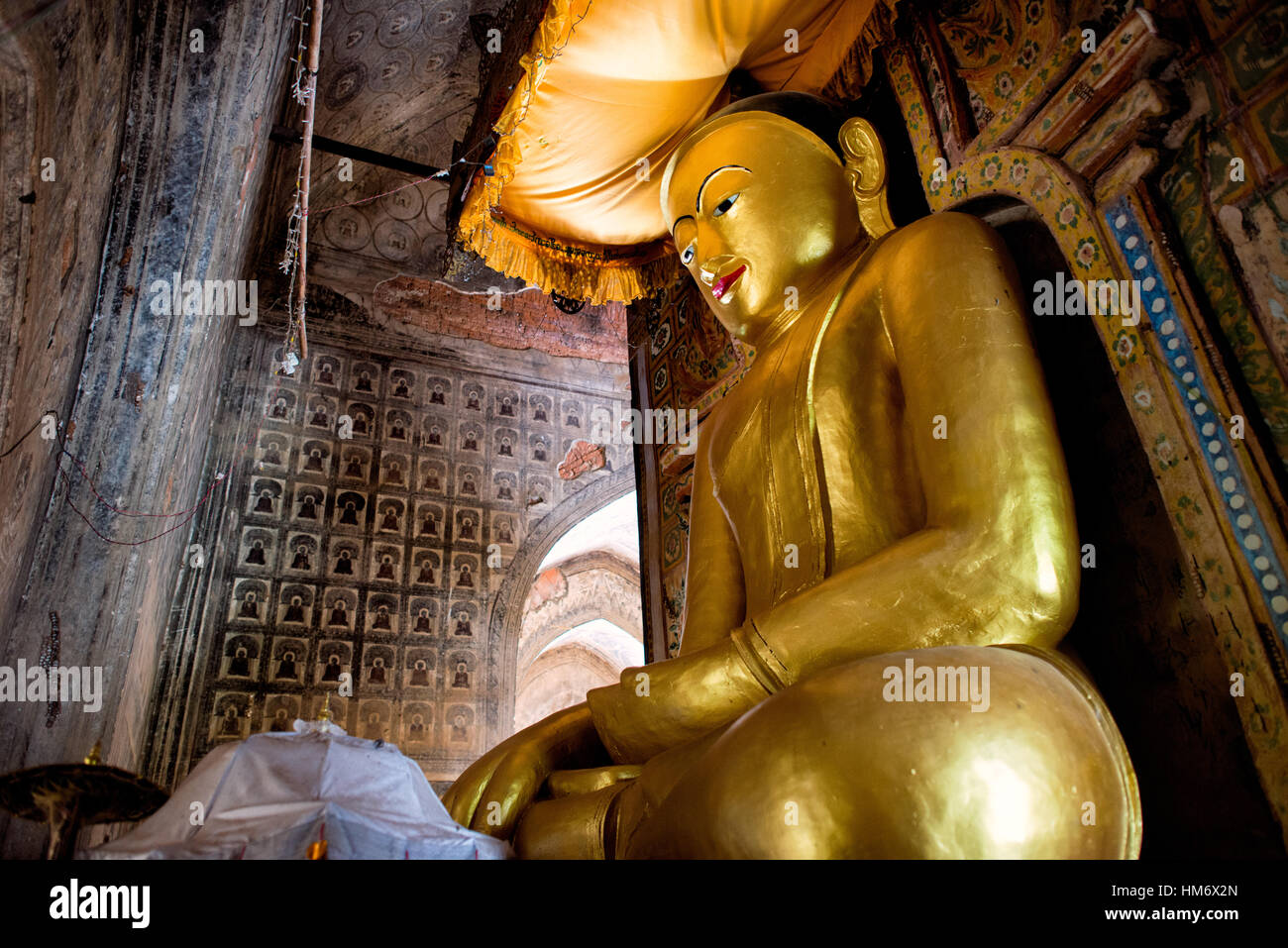 Lemyethna Temple Golden Buddha Statue Bagan Myanmar // BAGAN, Myanmar — A large golden Buddha statue occupies one of the cardinal shrines at Lemyethna Temple (also known as the Temple of the Four Faces), a Buddhist temple constructed in 1223 CE during the reign of King Htilominlo. Built by Anandathura, a minister at the royal court, the temple features four shrine rooms facing the cardinal directions, each housing a Buddha statue. Lemyethna Temple represents one of the final major temple projects of the Pagan dynasty and serves as the centerpiece of an extensive monastic complex comprising ove Stock Photohttps://www.alamy.com/image-license-details/?v=1https://www.alamy.com/stock-photo-lemyethna-temple-golden-buddha-statue-bagan-myanmar-bagan-myanmar-132917869.html
Lemyethna Temple Golden Buddha Statue Bagan Myanmar // BAGAN, Myanmar — A large golden Buddha statue occupies one of the cardinal shrines at Lemyethna Temple (also known as the Temple of the Four Faces), a Buddhist temple constructed in 1223 CE during the reign of King Htilominlo. Built by Anandathura, a minister at the royal court, the temple features four shrine rooms facing the cardinal directions, each housing a Buddha statue. Lemyethna Temple represents one of the final major temple projects of the Pagan dynasty and serves as the centerpiece of an extensive monastic complex comprising ove Stock Photohttps://www.alamy.com/image-license-details/?v=1https://www.alamy.com/stock-photo-lemyethna-temple-golden-buddha-statue-bagan-myanmar-bagan-myanmar-132917869.htmlRMHM6X2N–Lemyethna Temple Golden Buddha Statue Bagan Myanmar // BAGAN, Myanmar — A large golden Buddha statue occupies one of the cardinal shrines at Lemyethna Temple (also known as the Temple of the Four Faces), a Buddhist temple constructed in 1223 CE during the reign of King Htilominlo. Built by Anandathura, a minister at the royal court, the temple features four shrine rooms facing the cardinal directions, each housing a Buddha statue. Lemyethna Temple represents one of the final major temple projects of the Pagan dynasty and serves as the centerpiece of an extensive monastic complex comprising ove
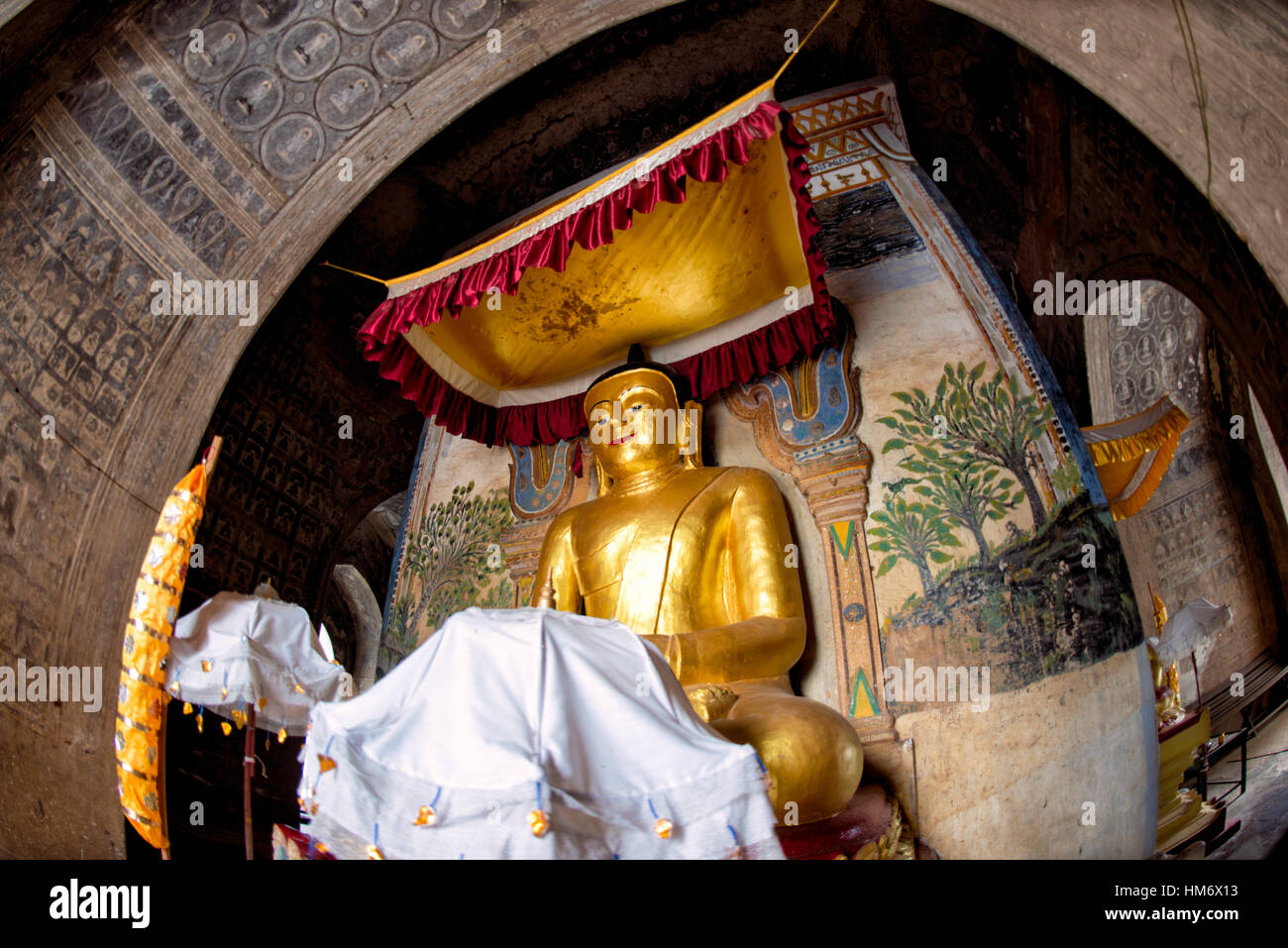 Lemyethna Temple Golden Buddha Statue Bagan Myanmar // BAGAN, Myanmar — A large golden Buddha statue occupies one of the cardinal shrines at Lemyethna Temple (also known as the Temple of the Four Faces), a Buddhist temple constructed in 1223 CE during the reign of King Htilominlo. Built by Anandathura, a minister at the royal court, the temple features four shrine rooms facing the cardinal directions, each housing a Buddha statue. Lemyethna Temple represents one of the final major temple projects of the Pagan dynasty and serves as the centerpiece of an extensive monastic complex comprising ove Stock Photohttps://www.alamy.com/image-license-details/?v=1https://www.alamy.com/stock-photo-lemyethna-temple-golden-buddha-statue-bagan-myanmar-bagan-myanmar-132917823.html
Lemyethna Temple Golden Buddha Statue Bagan Myanmar // BAGAN, Myanmar — A large golden Buddha statue occupies one of the cardinal shrines at Lemyethna Temple (also known as the Temple of the Four Faces), a Buddhist temple constructed in 1223 CE during the reign of King Htilominlo. Built by Anandathura, a minister at the royal court, the temple features four shrine rooms facing the cardinal directions, each housing a Buddha statue. Lemyethna Temple represents one of the final major temple projects of the Pagan dynasty and serves as the centerpiece of an extensive monastic complex comprising ove Stock Photohttps://www.alamy.com/image-license-details/?v=1https://www.alamy.com/stock-photo-lemyethna-temple-golden-buddha-statue-bagan-myanmar-bagan-myanmar-132917823.htmlRMHM6X13–Lemyethna Temple Golden Buddha Statue Bagan Myanmar // BAGAN, Myanmar — A large golden Buddha statue occupies one of the cardinal shrines at Lemyethna Temple (also known as the Temple of the Four Faces), a Buddhist temple constructed in 1223 CE during the reign of King Htilominlo. Built by Anandathura, a minister at the royal court, the temple features four shrine rooms facing the cardinal directions, each housing a Buddha statue. Lemyethna Temple represents one of the final major temple projects of the Pagan dynasty and serves as the centerpiece of an extensive monastic complex comprising ove
 Lemyethna Temple Frescoes Bagan Myanmar // BAGAN, Myanmar — Intricate frescoes composed of small tile-like illustrations creating geometric patterns adorn the interior walls and ceilings of Lemyethna Temple (also known as Lemyethna Pagoda), a Buddhist temple constructed in 1223 CE during the reign of King Htilominlo. Built by Anandathura, a minister at the royal court, the temple features a square base with elaborate stucco decorations and four shrine rooms housing Buddha statues facing the cardinal directions. The temple's decorative program originally included extensive mural paintings depic Stock Photohttps://www.alamy.com/image-license-details/?v=1https://www.alamy.com/stock-photo-lemyethna-temple-frescoes-bagan-myanmar-bagan-myanmar-intricate-frescoes-132917878.html
Lemyethna Temple Frescoes Bagan Myanmar // BAGAN, Myanmar — Intricate frescoes composed of small tile-like illustrations creating geometric patterns adorn the interior walls and ceilings of Lemyethna Temple (also known as Lemyethna Pagoda), a Buddhist temple constructed in 1223 CE during the reign of King Htilominlo. Built by Anandathura, a minister at the royal court, the temple features a square base with elaborate stucco decorations and four shrine rooms housing Buddha statues facing the cardinal directions. The temple's decorative program originally included extensive mural paintings depic Stock Photohttps://www.alamy.com/image-license-details/?v=1https://www.alamy.com/stock-photo-lemyethna-temple-frescoes-bagan-myanmar-bagan-myanmar-intricate-frescoes-132917878.htmlRMHM6X32–Lemyethna Temple Frescoes Bagan Myanmar // BAGAN, Myanmar — Intricate frescoes composed of small tile-like illustrations creating geometric patterns adorn the interior walls and ceilings of Lemyethna Temple (also known as Lemyethna Pagoda), a Buddhist temple constructed in 1223 CE during the reign of King Htilominlo. Built by Anandathura, a minister at the royal court, the temple features a square base with elaborate stucco decorations and four shrine rooms housing Buddha statues facing the cardinal directions. The temple's decorative program originally included extensive mural paintings depic
 Lemyethna Temple Golden Buddha Head Bagan Myanmar // BAGAN, Myanmar — A golden Buddha head from one of the large statues housed within Lemyethna Temple (also known as Lemyethna Pagoda), a Buddhist temple constructed in 1223 CE in the Minnanthu area of Bagan. Built by Anandathura, a minister during King Htilominlo's reign, the temple follows the classic Pagan architectural design with a square central shrine and porches extending in four cardinal directions. The temple forms the centerpiece of an extensive monastic complex comprising over 50 associated structures documented in the archaeologica Stock Photohttps://www.alamy.com/image-license-details/?v=1https://www.alamy.com/stock-photo-lemyethna-temple-golden-buddha-head-bagan-myanmar-bagan-myanmar-a-132917782.html
Lemyethna Temple Golden Buddha Head Bagan Myanmar // BAGAN, Myanmar — A golden Buddha head from one of the large statues housed within Lemyethna Temple (also known as Lemyethna Pagoda), a Buddhist temple constructed in 1223 CE in the Minnanthu area of Bagan. Built by Anandathura, a minister during King Htilominlo's reign, the temple follows the classic Pagan architectural design with a square central shrine and porches extending in four cardinal directions. The temple forms the centerpiece of an extensive monastic complex comprising over 50 associated structures documented in the archaeologica Stock Photohttps://www.alamy.com/image-license-details/?v=1https://www.alamy.com/stock-photo-lemyethna-temple-golden-buddha-head-bagan-myanmar-bagan-myanmar-a-132917782.htmlRMHM6WYJ–Lemyethna Temple Golden Buddha Head Bagan Myanmar // BAGAN, Myanmar — A golden Buddha head from one of the large statues housed within Lemyethna Temple (also known as Lemyethna Pagoda), a Buddhist temple constructed in 1223 CE in the Minnanthu area of Bagan. Built by Anandathura, a minister during King Htilominlo's reign, the temple follows the classic Pagan architectural design with a square central shrine and porches extending in four cardinal directions. The temple forms the centerpiece of an extensive monastic complex comprising over 50 associated structures documented in the archaeologica
 Nagayon Temple Buddha Statue Bagan Myanmar // BAGAN, Myanmar — A Buddha statue receives natural illumination through the perforated windows of Nagayon Temple (also known as Naga Yon Hpaya), located in the Myinkaba area of Bagan. Built around 1090-1105 AD during the reign of King Kyanzittha, this single-storey temple represents an important architectural prototype that preceded the construction of the renowned Ananda Temple. The temple's name derives from a legend in which a naga serpent protected the future king while he slept at this location during his exile. Nagayon Temple features distinct Stock Photohttps://www.alamy.com/image-license-details/?v=1https://www.alamy.com/stock-photo-nagayon-temple-buddha-statue-bagan-myanmar-bagan-myanmar-a-buddha-103795845.html
Nagayon Temple Buddha Statue Bagan Myanmar // BAGAN, Myanmar — A Buddha statue receives natural illumination through the perforated windows of Nagayon Temple (also known as Naga Yon Hpaya), located in the Myinkaba area of Bagan. Built around 1090-1105 AD during the reign of King Kyanzittha, this single-storey temple represents an important architectural prototype that preceded the construction of the renowned Ananda Temple. The temple's name derives from a legend in which a naga serpent protected the future king while he slept at this location during his exile. Nagayon Temple features distinct Stock Photohttps://www.alamy.com/image-license-details/?v=1https://www.alamy.com/stock-photo-nagayon-temple-buddha-statue-bagan-myanmar-bagan-myanmar-a-buddha-103795845.htmlRMG0T8JD–Nagayon Temple Buddha Statue Bagan Myanmar // BAGAN, Myanmar — A Buddha statue receives natural illumination through the perforated windows of Nagayon Temple (also known as Naga Yon Hpaya), located in the Myinkaba area of Bagan. Built around 1090-1105 AD during the reign of King Kyanzittha, this single-storey temple represents an important architectural prototype that preceded the construction of the renowned Ananda Temple. The temple's name derives from a legend in which a naga serpent protected the future king while he slept at this location during his exile. Nagayon Temple features distinct